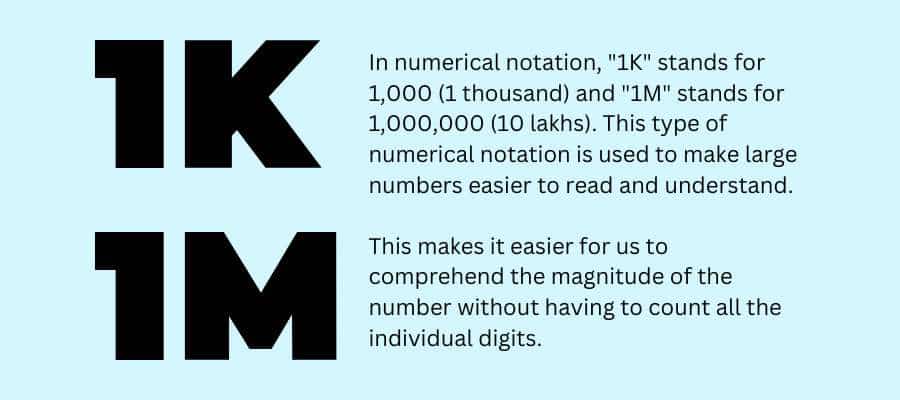
Understanding 1K and 1M Notations – A Comprehensive Guide
The digital world is full of abbreviations that have become part of our everyday language. Two of the most common ones you’ll encounter across social media, finance, and technology are 1K and 1M. If you’ve ever wondered about the meaning of 1K or the meaning of 1M, you’re not alone. In this article, I’ll explore what these abbreviations stand for, their origins, and why they’re so important in today’s communication landscape. From social media followers to financial reports, these shorthand notations have become essential in how we express numbers in the digital age.

The Origin of 1K and 1M
Before diving into their uses, let’s understand where these abbreviations came from.
The Story Behind ‘K’
The ‘K’ in 1K originates from the Greek word ‘khilioi’ (χίλιοι), which means ‘thousand’. The French later shortened ‘khilioi’ to ‘kilo’, which is how terms like kilometre and kilogram entered our vocabulary. Since a kilogram represents 1,000 grams, the symbol for a thousand naturally became ‘K’.
You might wonder why we use ‘K’ instead of ‘T’ for thousand. While ‘T’ might seem more logical as the first letter of ‘thousand’, it has no historical or linguistic connection to the concept of a thousand. Additionally, ‘T’ is already used in scientific notation for ‘tera’, which represents one trillion (1,000,000,000,000). Using ‘K’ avoids this potential confusion.
Where Does ‘M’ Come From?
The ‘M’ used to represent million comes from the metric system prefix ‘mega’, which also has Greek origins. Just as ‘kilo’ represents a thousand, ‘mega’ represents a million. This standardization through the metric system has helped create consistency in how we express large numbers globally.
What Does 1K Mean?
Simply put, 1K means 1,000 or one thousand. When you see 1K, it’s a shorter way of writing 1,000. This abbreviation has become incredibly common in our digital world where space and brevity are valued.
1K in Everyday Use
Let me share some examples of how 1K is used in daily life:
- Social Media: When an Instagram post has “1K likes,” it means 1,000 people have liked the post.
- Money: When someone says, “I spent 5K on my new phone,” they mean they spent 5,000 rupees.
- Distance: A “5K run” refers to a five-kilometre race (5,000 metres).
- Salary: When a job listing mentions “₹30K monthly,” it means a monthly salary of 30,000 rupees.
In India, we commonly use 1K in casual conversations about money. Instead of saying “I need ten thousand rupees,” many people simply say “I need 10K.”
What Does 1M Mean?
1M stands for 1,000,000 or one million. In the Indian number system, 1 million equals 10 lakhs. Just like 1K, 1M provides a concise way to express a large number.
1M in Indian Context
In India, we often convert between the international system and our local numbering system. Here’s how 1M translates:
- 1M = 10,00,000 in Indian numerical format
- 1M = 10 Lakhs
- 1M = 0.1 Crore
When we talk about 1 million views on YouTube, we’re referring to 10 lakh views – a significant milestone for Indian content creators.
Why Are These Abbreviations Important?
Now that we understand the meaning of 1K and the meaning of 1M, let’s explore why these abbreviations have become so important in our digital world.
Saves Space and Time
In today’s fast-paced digital communication, brevity is key. Writing “1K” instead of “1,000” or “1M” instead of “1,000,000” saves space and time, especially in platforms with character limits like Twitter.
Universal Understanding
These abbreviations have become universally understood across different languages and cultures. Whether you’re in Mumbai or Manhattan, 1K and 1M mean the same thing, creating a common numerical language.
Visual Clarity
Large numbers with many zeros can be difficult to read quickly. Using 1K and 1M makes numbers more visually manageable and reduces the chance of misreading zeros.
1K and 1M in Social Media
Follower Milestones
On social media, reaching 1K or 1M followers represents significant milestones. For many Indian creators, crossing the 1K followers mark is the first step toward building an audience, while reaching 1M (10 lakh) followers can be life-changing.
Monetization Potential
These numbers aren’t just for show – they translate directly to earning potential. In India, creators with 1K followers on Instagram can earn approximately ₹117,590 per month, while those with over 1M followers can earn around ₹127,630 monthly.
Consider these examples:
- A fashion influencer with 50K followers might charge ₹15,000 for a sponsored post
- A celebrity with 10M followers might earn ₹10 lakhs or more for a single brand collaboration
Engagement Metrics
Social platforms often display engagement metrics using these abbreviations:
- “Video has 1.5K comments”
- “Post reached 500K people”
- “Tweet got 2M impressions”
1K and 1M in Finance and Business
Financial Reporting
In business documents and financial reports, 1K and 1M are commonly used to keep reports clean and readable:
- “Company revenue grew to ₹50M this quarter”
- “Project budget is ₹200K”
- “Startup raised ₹2M in seed funding”
Investment Discussions
When discussing investments in India, these abbreviations help simplify conversations:
- “SIP of ₹5K monthly”
- “Property value increased by ₹2M in five years”
- “Mutual fund requires minimum investment of ₹1K”
1K and 1M in Technology
Data Storage
In computing, 1K traditionally represents 1,024 bytes (slightly more than 1,000 due to binary counting), while 1M represents 1,048,576 bytes. However, in common usage, they’re often rounded to 1,000 and 1,000,000 respectively.
Common examples include:
- “Smartphone with 128K cache memory”
- “Internet package with 1M download speed”
- “Cloud storage offering 5M space”
Technical Specifications
Tech products often use these abbreviations in their specifications:
- “Router with 1K buffer size”
- “Camera with 1M pixels resolution”
- “Processor with 16K instruction set”
Common Misconceptions About 1K and 1M
Industry-Specific Variations
It’s worth noting that in some traditional finance sectors, ‘M’ can actually refer to thousand (from the Roman numeral M for 1,000), and ‘MM’ is used for million (thousand-thousand). This can create confusion when transitioning between industries.
Regional Differences
While these abbreviations are becoming standard globally, some regions might use different notations. In India, we often use lakhs and crores alongside K and M, creating a hybrid numerical language that combines both systems.
What is the Difference between 1k and 1M Notations?
When talking about large numbers, it is important to understand the difference between thousand and million notations. Thousand notation (1000) is used to represent one thousand, while million notation (1000000) is used to represent one million or ten lakhs.
Understanding the difference between these two numerical notations can help you avoid confusion when dealing with large numbers. It also helps you understand how much a number actually represents in terms of value or quantity. Knowing the difference between thousand and million notations can be especially helpful when dealing with financial matters or making calculations involving larger quantities of items or money.
How to Use Thousand and Million Notations in Everyday Life
Numerical notation systems are used to represent numbers in writing. They are used for both commercial and scientific purposes. The most commonly used numerical notation system is the decimal system, which uses base 10 to represent numbers. However, there are many other numerical notation systems that have been developed over the years, such as the binary system, octal system, hexadecimal system and more.
In addition to these numerical notation systems, there are also abbreviations for large numbers such as bn (billion), tr (trillion) and qd (quadrillion). These abbreviations can be used to make long numbers easier to read and write. Furthermore, understanding the difference between billion vs trillion vs quadrillion is important when using these abbreviations correctly.
Conclusion
Understanding the meaning of 1K and the meaning of 1M is increasingly important in our digitally connected world. From representing 1,000 and 1,000,000 respectively, these abbreviations have become essential shorthand in how we communicate large numbers across social media, finance, technology, and everyday conversations.
For us in India, these abbreviations exist alongside our traditional number system of lakhs and crores, creating a rich numerical vocabulary that bridges international and local communication styles. Whether you’re tracking your social media growth, discussing salary, or reading tech specifications, knowing what 1K and 1M represent helps you navigate the modern digital landscape with confidence.
The next time you see someone celebrating their 1K followers or a company reporting 1M in revenue, you’ll not only understand what those numbers mean but also appreciate the historical and practical significance behind these ubiquitous abbreviations.
Frequently Asked Questions
In finance, what is a “1k investment”?
1k investment in finance typically refers to an investment of ₹1,000. You can make this reference for purchasing stocks, bonds, mutual funds, or other financial assets. For example is someone said he bough stocks of ITC for 1K, it would mean that the person bought shares of ITC of Rs 1000.
What does “1m revenue” mean in a company’s financial statement?
“1m revenue” in a company’s financial statement means that the company has generated ₹1 million in revenue during a specific period. “1m” is an abbreviation for “one million,” which is equivalent to 10 Lakhs.
If a company has a market capitalization of $500 million, how would you express this using “1m”?
If a company has a market capitalization of $500 million, this can be expressed as a “0.5m market cap” using “1m” as the abbreviation for one million. A company with a market cap of $500 million has a value of half a billion dollars. The term “0.5m” is an abbreviation for “0.5 million,” which is equivalent to $500,000. Expressing market capitalization in terms of “1m” can be a useful way to simplify large numbers and make them easier to compare across different companies.
If a company has a market capitalization of $500 million, how would you express this using “1m”?
In the International System of Units (SI), the symbol for “1m” is “M”. However, it is important to note that in finance and economics, “M” is often used to represent “million”, rather than “meter” which is the standard SI unit represented by “M”. This can sometimes lead to confusion, so it is important to pay attention to the context in which the abbreviation is being used. In finance and economics, “M” is commonly used to represent monetary units such as millions or billions of dollars or other currencies.
When someone has 1M followers in instagram what does it mean?
Having 1M followers on Instagram would mean that the person has 10 Lakh followers. By international standards, 10 Lakh is also referred to as 1 Million.
Share this insight




